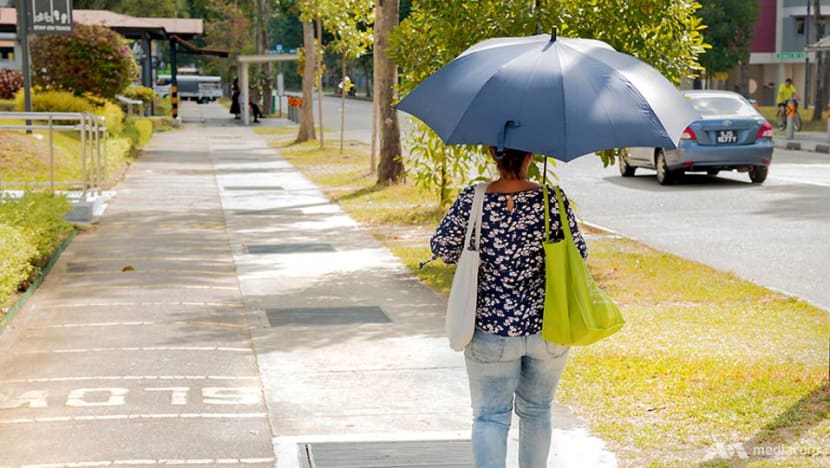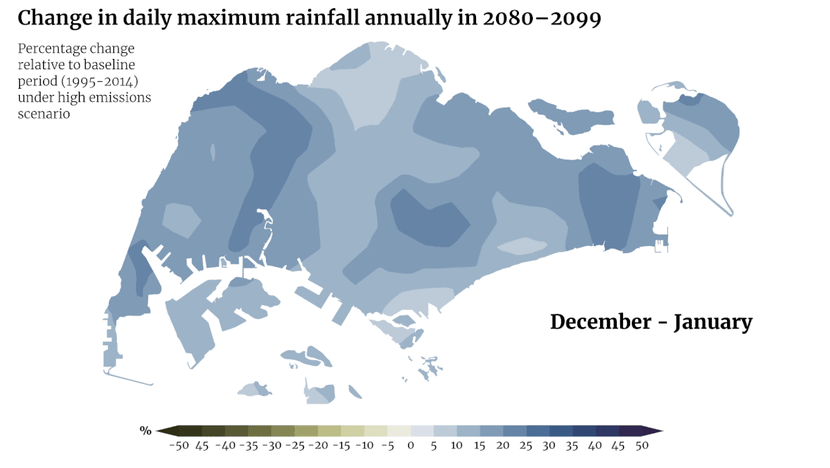More sweltering days, intense rain under worst-case scenario in Singapore's third climate change study
The latest study provides updated data for climate variables according to three scenarios with different levels of carbon emissions.

File photo of a woman walking down a street in Singapore. (File photo: Gaya Chandramohan)

This audio is generated by an AI tool.
- Singapore released its third National Climate Change Study detailing climate change projections up to 2100
- The study produces data relating to sea levels, temperature, rainfall, wind, and humidity according to three climate change scenarios
- Results show that some variables, such as sea level, are already locked in no matter what action the world takes
SINGAPORE: By the end of the century, Singapore could experience more weather extremes under a worst-case climate change scenario, with more frequent very hot days, more extreme daily rainfall as well as longer and more frequent dry spells.
That is the picture painted by Singapore's third National Climate Change Study should carbon emissions remain high, driven by "energy-intensive, fossil fuel-based development".
The regional study released on Friday (Jan 5) by the Centre for Climate Research Singapore details the expected changes in key climate variables such as temperature, rainfall, humidity, wind, sea level, change in means and extremes.
"Climate change is no longer a distant threat; it has become an undeniable and immediate challenge for humanity," said the National Environment Agency's (NEA) chief executive officer Wong Kang Jet in the stakeholder report condensing the study's findings.
"Its consequences, felt across the globe, are particularly acute for small island nations like Singapore."
On Friday, Minister for Sustainability and the Environment Grace Fu announced the release of the study's results at a symposium, where she also unveiled a data visualisation portal based on the findings.
"Version three shows that we will have to contend with more extreme climate conditions - higher temperatures, heavier rainfalls and longer and more frequent dry spells. These climate conditions may also lead to other indirect climate challenges, including disruptions to water and food," said Ms Fu.
She noted that extreme weather has been seen across the globe, including in Singapore which matched its historical high temperature of 37 degrees Celsius in May last year.
"The heat, coupled with high humidity in our environment, brings serious health risks. Such extreme weather occurrences are projected to increase in frequency and intensity, and undoubtedly many of us are concerned how much more worse they may become, and how we are preparing," she said.
"Armed with these projections, we will strive to safeguard a sustainable, resilient and liveable Singapore for our future generations, just as our forefathers had done for us."
The Daily Cuts: What a hotter Singapore means
MORE VERY HOT DAYS, INTENSE RAINFALLS
Singapore's projections are based on three global warming scenarios included in the Intergovernmental Panel on Climate Change's sixth assessment report – namely low, moderate and high carbon emissions scenarios.The low carbon emissions scenario is when the international community meets net zero targets after 2050 and aims to limit global temperature increases to well below 2 degrees Celsius above pre-industrial levels.
The moderate emissions scenario represents some mitigation efforts, where greenhouse gas concentrations peak mid-century before declining – but carbon dioxide concentrations still end up being much higher than they are today.
The high emissions scenario assumes that greenhouse gas concentrations – driven by fossil-fueled development – continue to increase at about the same rate as they are today, resulting in very high concentrations.
According to the latest study, Singapore is likely to become warmer, and the rate of increase in annual mean temperature per decade is set to rise. Over the past 40 years, this rate was 0.24 degrees Celsius.
By the end of the century, annual mean temperatures are projected to rise by 0.55 degrees Celsius per decade under the high emissions scenario. This would translate to annual mean temperatures rising by 5 degrees Celsius by the end of the century.
Under the most optimistic scenario, the annual mean temperature rise would be 0.6 degrees Celsius.
Very hot days, which are days when the daily maximum temperature exceeds 35 degrees Celsius, will also become more frequent.
In the past 40 years, Singapore experienced such temperatures on an average of 21.4 days per year. By the end of the century, this would increase to an average of 41 days under the low emission scenario and 351 days under the high emissions model.
More warm nights with temperatures exceeding 26.3 deg Celsius are also expected. In the past 40 years, Singapore had an average of 76 nights a year with such temperatures. By the end of the century, that could change to most nights.
Singapore is also projecting more extreme daily rainfalls across all seasons but with more frequent and longer dry spells. The country could experience, on average, one dry spell every 10 to 60 months by the end of the century.

Under all three scenarios, Singapore will see mean sea levels rise by 0.23m to 1.15m by the end of the century, exceeding previous estimates of 1m by 2100. By 2150, mean sea levels may increase by up to around 2m under the high emissions scenario.
Singapore already has sea walls and stone embankments protecting 70 per cent of its coastline but is looking to do more. It is also conducting studies to assess the best way to protect different shorelines. One example of a site-specific measure is the Long Island project, which involves reclaiming 800ha of land at east coast to protect the low-lying area.
Another is the polder project at Pulau Tekong, which will be completed by the end of this year. Polders are tracts of land that lie below sea level and are reclaimed through dykes, drainage canals and pumping stations. Water that enters polders is pumped out by the system.
Wind speed is also likely to increase by up to 20 per cent by 2100 across all three scenarios by the end of the century. By this time period, daily maximum wind gusts are likely to increase, which may cause potential damage to Singapore's infrastructure and injury to residents.
IMPROVED CAPABILITIES, EXPANDED PROJECTIONS
The third version of the National Climate Change Study comes nine years after the second. It provides updated data that will inform climate change adaptation strategies and policies against knock-on effects on food security, water security and other aspects of life.
The study adapts and downsizes global climate models from the Intergovernmental Panel on Climate Change's (IPCC) sixth assessment report to provide more detailed climate projections specific to Singapore and its surrounding region. The Centre for Climate Research Singapore partnered the National Supercomputing Centre on the process, which Ms Fu likened to zooming in from a big world map to a map of Singapore that displays streets and landmarks.
Scientists used three supercomputers to complete climate simulations over three-and-a-half years, producing the world’s highest-resolution climate projections for Singapore and Southeast Asia until the end of the century.
The study is an improvement over its predecessor in other ways. It measures future scenarios based on the IPCC's shared socioeconomic pathways, which are more comprehensive than the previously used representative concentration pathway.
Version three also extends sea-level projections up to the year 2150 and beyond. This version also offers projections for six tide gauges that measure mean sea level rise around Singapore compared to its predecessor's singular representation.
The range of values projected in version three is comparable with those of version two. Certain variables, such as mean daily temperature, are slightly higher in version three, while others, such as mean maximum daily temperature, have slightly higher values in version two.
For sea level rise, the comparable scenarios between version two and version three show a higher increase in mean sea level in the latest version.
Singapore's findings have been digested into a stakeholder report for the general public, researchers and government agencies. Those who want more details on the science behind the study's methodology and projections can refer to a separate science report.
Singapore will share its findings with member states of the Association of Southeast Asian Nations and will collaborate with entities on a more international scale for joint research using the data.
In conjunction with the report's release on Friday, NEA announced the second grant call under the Climate Impacts Science Research Programme for new research proposals on aspects affected by climate change, including food security, water resources, and flood management and infrastructure.
The first grant call, launched last year under the Climate Impact Science Research Programme, involves projects that will investigate the impact of climate change on vector-borne and chronic diseases, among other things. Ms Fu announced on Friday that eight projects were awarded under the first grant call to researchers across Institutes of Higher Learning.
Graphics by Clara Ho
Animated map by Rafa Estrada
Source: Meteorological Service Singapore, Centre for Climate Research Singapore


















